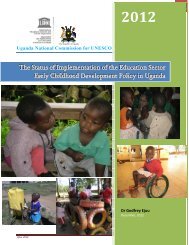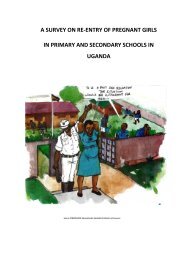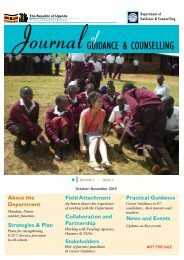Download Pdf - Ministry of Education and Sports
Download Pdf - Ministry of Education and Sports
Download Pdf - Ministry of Education and Sports
Create successful ePaper yourself
Turn your PDF publications into a flip-book with our unique Google optimized e-Paper software.
As a result <strong>of</strong> this policy the proportion <strong>of</strong> female enrolment at tertiary level has grown more rapidly<br />
than at secondary level. In 2000, the proportion <strong>of</strong> female enrolment was 36.7% <strong>and</strong> now st<strong>and</strong>s at 44%<br />
(see Figure 7.5).<br />
Despite progress, gender disparities in secondary <strong>and</strong> tertiary education remain a major concern <strong>of</strong><br />
the sector. A lot still remains to be done in narrowing the gender gaps at these levels. The current<br />
status <strong>of</strong> girls’ enrolment in secondary <strong>and</strong> tertiary education levels is presented in Figure 4.32<br />
Figure 4.32: Percentage share <strong>of</strong> females in Secondary <strong>and</strong> Tertiary <strong>Education</strong> 20062012<br />
6 0 .0 0 %<br />
100<br />
t s<br />
n<br />
e<br />
d<br />
s t u<br />
a<br />
l e<br />
m<br />
f e<br />
o<br />
a<br />
g<br />
e<br />
%<br />
5 0 .0 0 %<br />
4 0 .0 0 %<br />
3 0 .0 0 %<br />
2 0 .0 0 %<br />
1 0 .0 0 %<br />
0 .0 0 %<br />
2000 2001 2002 2003 2004 2005 2006 2007 2008 2009 2010 2011 2012 2015*<br />
Seco n d a ry 44.08% 44.09% 45.19% 45.19% 45.00% 44.98% 45.50% 45.80% 45.90% 45.70% 46.60% 47% 46% 50%<br />
T e rtia r y 36.7% 37.1% 38.4% 39.3% 40.0% 40.7% 42.1% 43.1% 43.6% 43.7% 43.8% 43.8% 44% 50%<br />
Y e ar<br />
Source: EMIS 20002012<br />
There is a high chance that the gender gap <strong>of</strong> 8 percent in favor <strong>of</strong> boys (54%) at secondary education<br />
level could be eliminated by 2015. The gender gap (12%) at tertiary education requires additional<br />
affirmative action to eliminate. Government introduced an additional 1.5 points for girls joining<br />
tertiary education way back as a strategy to eliminate the gap. This affirmative action has made<br />
positive impact <strong>and</strong> it is hoped that the introduction <strong>of</strong> USE will help to improve the status quo.<br />
4.5 Trends <strong>of</strong> EFA Goals<br />
The Dakar Framework for Action is a collective commitment to action by countries, based on the<br />
World Declaration on <strong>Education</strong> for All (Jomtien, 1990) <strong>and</strong> supported by the Universal Declaration <strong>of</strong><br />
Human Rights, <strong>and</strong> the Convention on the Rights <strong>of</strong> the Child. It recognizes that ‘all children, young<br />
people <strong>and</strong> adults have the human right to benefit from an education that will meet their basic<br />
learning needs in the best <strong>and</strong> fullest sense <strong>of</strong> the term, an education that includes learning to know,<br />
to do, to live together <strong>and</strong> to be.<br />
It is an education geared to tapping each individual’s talents <strong>and</strong> potential <strong>and</strong> developing learners’<br />
personalities so that they can improve their lives <strong>and</strong> transform their societies.’ <strong>Education</strong> For All is<br />
the key to sustainable development, peace <strong>and</strong> stability within <strong>and</strong> among countries.<br />
The Dakar Framework for Action identified six (6) goals for the international community to achieve<br />
by 2015, <strong>and</strong> also reaffirmed the right to education as a fundamental human right. The Six (6) EFA<br />
Goals as agreed upon by the international community include;<br />
ESSAPR FY 2011/12 to inform the 19 th ESSR – OCTOBER 2012








